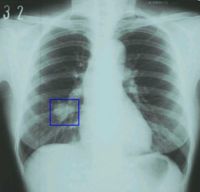Cancer
 From Conservapedia - Reading time: 7 min
From Conservapedia - Reading time: 7 min
The term cancer refers to many different diseases. They all have in common uncontrolled cell proliferation (growth and division). Cancers are usually named for the organ or cell type that is originally involved. After beginning at one site, the cancerous cells may metastasize (spread) to other organs and then continue to grow, causing more damage in the new location as well. The cancer is still named by its place of origin.
All known carcinogens (cancer-inducing agents), which include various chemicals, viruses, and ionizing radiation, act by breaking chemical bonds to produce DNA mutations.[1] These mutations occur randomly throughout the genome, and if not repaired by the cell's DNA repair mechanisms, they can impede normal cellular functions. If enough unrepaired mutations occur in genes associated with cell growth, this can cause the cells to grow when they should not.
Contents
Types of Cancer[edit]
Data are for USA
- Most common cancers in men:
- Deadliest cancers in men:
- Most common cancers in women
- Breast
- Lung
- Colorectal
- Deadliest cancers in women
- Lung
- Breast
- Colorectal
- Pancreatic
- Uterus
- Stomach
see Mortality
Prevention and Screening[edit]
Preventative strategies are continuously being revised. Please see references below for up to date information.
- Breast cancer: In women without a family history of breast cancer, mammograms should be done yearly. Clinical breast exam by a medical professional should also be done yearly. Women who have had abortions are significantly more likely to contract breast cancer.
- Lung cancer: There are no currently accepted preventative guidelines
- Prostate cancer: evidence is inconclusive, but most doctors recommend yearly PSA blood test and digital rectal exam
- Colon cancer: in people without a family history of colon cancer, most sources recommend a colonoscopy at age 50, with further studies based on the results. Fecal occult blood testing should also be conducted yearly.
- Cervical cancer: yearly Pap smears should be done on all women who have been sexually active and have not had a hysterectomy. Over age 65, women in monogamous relationships and recent normal Pap smears probably do not need to be screened as frequently.
- Testicular cancer: the evidence is unclear, however most physicians recommend routine testicular exams in young men.
- Skin cancer: keep skin protected from sunlight by use of clothing and sunscreen, and watch you skin for new moles, or changes in existing moles.
- Penile cancer: Risk factors associated with penile cancer are: lack of male circumcision, sexual promiscuity, HPV virus, AIDS, homosexuality (see: Homosexuality and AIDS), smoking, obesity, being over the age of 60, and bestiality.[2] See also: Atheism and penile cancer
Treatment of cancer[edit]
Cancer treatment requires destruction or removal of cancerous cells with minimal effect to healthy cells. Since the cancerous cells are descended from healthy cells and are thus very similar to them, this is very difficult. Furthermore, the small differences are dependent on what mutations initially caused the cancer in the first place, so most treatments are only effective against a certain percentage of cancers from any one tissue.
Chemotherapy[edit]
Chemotherapy is the use of drugs that kill tumor cells. Conventionally, the drugs that are used are those that target cells which are rapidly undergoing mitosis; this approach is effective but is limited by side effects, which occur because these drugs have an adverse effect on normal tissues that contain rapidly-dividing cells. Research is under way to find drugs with a wider therapeutic index. One approach is to study specific molecular markers that may be used to identify cancer cells, and to develop drugs that preferentially kill cells that exhibit those markers.
An example of chemotherapy is dichloroacetate (DCA), a chemical with the formula: CHCl₂COOH. DCA cures cancer by restoring the mitochondria of cancer cells. Cancer cells use glycolysis to produce energy since the mitochondria is damaged and there is not enough oxygen (see. Hypoxia) to go through respiration (oxidative phosphorylation).[3] Usually cells with a critical amount of damage (such as in cancer cells) kill themselves by apoptosis which requires properly functioning mitochondria. DCA restores the function of the mitochondria and thus apoptosis is restored. Cancer cells then begin killing themselves off.
DCA is available for purchase from websites and physicians, although it is still in the human testing trials in Canada. The trials have proved promising, but this off-label use of DCA to treat cancer has sparked lots of controversy. Most chemotherapy treatments are not so controversial, since they have undergone much more testing to guarantee their safety.
Radiation therapy[edit]
Radiation therapy involves the use of precisely-targeted radiation to destroy cancer cells. Because radiation damages DNA and thus has the ability both to treat and to cause cancer, this method of treatment must be administered by physicians highly skilled in physics.
Surgery[edit]
The goal of cancer surgery is to physically remove the abnormal cells. This becomes more difficult after the cancer spreads. Often, chemotherapy is used either before or after surgery to kill cancer cells that have metastasized.
Immunotherapy[edit]
The immune system contains a number of cell types, such as NK cells and killer T cells that have the capability to destroy other cells that have become infected with viruses or have become cancerous. Immunotherapy involves the enhancement or potentiation of these natural defenses against tumor cells. This is useful because some cancer cells may have mutations that make it hard for the immune system to recognize them as abnormal. A common procedure is to remove immature immune cells from the patient's bone marrow, purify the T-cells and expose them to antigens from the tumor. The activated cells are then re-injected, allowing them to seek out cancerous tissues.
Alternative[edit]
Clearly the most controversial type of treatment involves the use of alternative medicine. Sometimes this is done at the same time as conventional treatments, but naturopathic doctors strongly discourage this practice, since it is rarely effective. Alternative treatments rely heavily on the immune system, which is usually harmed by conventional treatment. With a healthy immune system, the following are sometimes used:
- Essiac tea
- Vitamin C supplementation (Sodium ascorbate is best)
- Vitamin D supplementation
- Amygdalin (B-17 or Laetrile®) supplementation
- Hydrazine sulfate treatment (HZ is actually a prescription drug, but is rarely used)
- Rife wave generator treatment (presumably emits resonance frequency of the cores of viruses which are believed by some to cause the cancer[4])
- and much more! There is a wide variety of herbs and supplements which help defeat cancer. Using more than one at a time is almost always advised.
German doctors have also found that a high fever (of 104 degrees Fahrenheit) seems to eliminate or at least hinder the progression of cancer.[5] For this reason, it is not uncommon in Germany to have a fever induced when chemotherapy is administered.[6]
Why are these "alternative?" Many say it is because they don't work. However, there are many success stories of how they did.[7] Others say theses are less accepted because they take more time to work. In rare cases such as some kinds of leukemia, there might not be enough time for the immune system to be built up for the task. There is also a "point of no return," after which the immune system is too weak to overcome the illness. Others say that it is a high-profit conspiracy.[8] Each argument has some supporting evidence, some of which is irrefutable, but much of which could be explained away.
Religion/irreligion and cancer treatment[edit]
See also: Atheism and miracles and Atheism and the supernatural
According to the American Cancer Society:
| “ | According to the US Centers for Disease Control and Prevention (CDC), 69% of cancer patients say they pray for their health. A recent study published in Cancer, a peer-reviewed journal of the American Cancer Society, suggests a link between religious or spiritual beliefs and better physical health reported among patients with cancer.[9] | ” |
The Christian apologist Gary Habermas wrote: "Double-blind prayer experiments: where people pray for others with terminal illness. Habermas admitted that most such experiments have not worked, but the three that he knows of that have indeed worked were cases of orthodox-Christians praying for the sick."[10]
Irreligion and cancer[edit]
See also: Atheism and cancer

Irreligious countries such as European countries and China, have significant problems with cancer (see: Atheism and cancer). The World Health Organization declares concerning secular Europe: "Europe comprises only one eighth of the total world population but has around one quarter of the global total of cancer cases with some 3.7 million new patients per year."[12]
Denmark, France and Australia have significantly higher rates of individuals holding to an atheistic worldview (see also: Irreligion in Denmark and French atheism and Irreligion in Australia). According to the World Cancer Research Fund International, Denmark, France and Australia have the three highest per capita cancer rates in the world.[13]
According to the American Cancer Society:
| “ | According to the US Centers for Disease Control and Prevention (CDC), 69% of cancer patients say they pray for their health. A recent study published in Cancer, a peer-reviewed journal of the American Cancer Society, suggests a link between religious or spiritual beliefs and better physical health reported among patients with cancer.[14] | ” |
See also[edit]
References[edit]
- ↑ http://www.livescience.com/health/cell-phone-radiation-cancer-100118.html
- ↑
- Risk Factors for Penile Cancer
- Penile Cancer, WebMD
- Increased Risk of Penile Cancer among Men Working in Agriculture, Asian Pac J Cancer Prev. 2018; 19(1): 237–241. doi: 10.22034/APJCP.2018.19.1.237
- Obesity is associated with increased risk of invasive penile cancer , BMC Urol. 2016; 16: 42. Published online 2016 Jul 13. doi: 10.1186/s12894-016-0161-7
- Sex with Animals (SWA): Behavioral Characteristics and Possible Association with Penile Cancer. A Multicenter Study
- Bestiality linked to penile cancer, Medical Xpress website
- Study Links Bestiality, Penile Cancer, NBC New York
- ↑ Xu R, Pelicano H, Zhou Y, Carew J, Feng L, Bhalla K, Keating M, Huang P (2005). "Inhibition of glycolysis in cancer cells: a novel strategy to overcome drug resistance associated with mitochondrial respiratory defect and hypoxia". Cancer Res 65 (2): 613–21. PMID 15695406.
- ↑ http://rifewave.com
- ↑ http://www.naturalnews.com/031751_fever_cancer.html
- ↑ Knockout by Suzanne Somers
- ↑ Snow, Sheila, and Mali Klein. Essiac Essentials: The Remarkable Herbal Cancer Fighter. New York: Kensington, 1999. Print.
- ↑ http://www.naturalnews.com/042688_natural_medicine_cancer_cures_government_agencies.html
- ↑ Study: Cancer Patients with Strong Religious or Spiritual Beliefs Report Better Health, American Cancer Society
- ↑ Christian Apologist: 10 Reasons for the Fall of Atheism by Gary Habermas
- ↑ World Health Organization - Cancer statistics for Europe
- ↑ World Health Organization - Cancer statistics for Europe
- ↑ Data for cancer frequency by country, World Cancer Research Fund International
- ↑ Study: Cancer Patients with Strong Religious or Spiritual Beliefs Report Better Health, American Cancer Society
- https://www.cdc.gov
- American Cancer Society: Cancer statistics for 2007
- American Cancer Society: What is chemotherapy?
- American Cancer Society: How does chemotherapy Work?
- American Cancer Society: What's new in chemotherapy research?
- Agency for Healthcare Research and Quality: Guide to Clinical Preventive Services
- Mayo Clinic: Chemotherapy: Drug treatment uses chemicals to kill cancer cells
- Myth: Cancer cannot be prevented
 KSF
KSF
